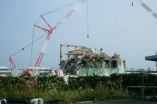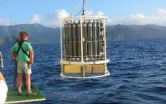(Press-News.org) The tsunami in Japan in March 2011 unleashed a series of negligence related with the resulting nuclear disaster. A scientific study headed by Spanish researchers has for the first time identified those atomic power plants that are more prone to suffering the effects of a tsunami. In total, 23 plants are in dangerous areas, including Fukushima I, with 74 reactors located in the east and southeast of Asia.
Tsunamis are synonymous with the destruction of cities and homes and since the Japanese coast was devastated in March 2011 we now know that they cause nuclear disaster, endanger the safety of the population and pollute the environment. As such phenomena are still difficult to predict, a team of scientists have assessed "potentially dangerous" areas that are home to completed nuclear plants or those under construction.
In the study published in the 'Natural Hazards' journal, the researchers drew a map of the world's geographic zones that are more at risk of large tsunamis. Based on this data, 23 nuclear power plants with 74 reactors have been identified in high risk areas. One of them includes Fukushima I. Out of them, 13 plants with 29 reactors are active; another four, that now have 20 reactors, are being expanded to house nine more; and there are seven new plants under construction with 16 reactors.
"We are dealing with the first vision of the global distribution of civil nuclear power plants situated on the coast and exposed to tsunamis," as explained to SINC by José Manuel Rodríguez-Llanes, coauthor of the study and researcher at the Centre for Research on the Epidemiology of Disasters (CRED) of the Catholic University of Leuven in Belgium. The authors used historical, archaeological, geological and instrumental records as a base for determining tsunami risk.
Despite the fact that the risk of these natural disasters threatens practically the entire western coast of the American continent, the Spanish/Portuguese Atlantic Coast and the coast of North Africa, the Eastern Mediterranean and areas of Oceania, especially in South and Southeast Asia are at greater risk due to the presence of atomic power stations.
For Debarati Guha-Sapir, another coauthor of the study and CRED researcher, "the impact of natural disaster is getting worse due to the growing interaction with technological installations."
VIDEO:
23 nuclear power plants are in tsunami risk areas
Click here for more information.
China: a nuclear power in the making
Some 27 out of 64 nuclear reactors that are currently under construction in the world are found in China. This is an example of the massive nuclear investment of the Asian giant. "The most important fact is that 19 (two of which are in Taiwan) out of the 27 reactors are being built in areas identified as dangerous," state the authors of the study.
In the case of Japan, which in March 2011 suffered the consequences of the worse tsunami in its history, there are seven plants with 19 reactors at risk, one of which is currently under construction. South Korea is now expanding two plants at risk with five reactors. India (two reactors) and Pakistan (one reactor) could also feel the consequences of a tsunami in the plants.
The ghost of Fukushima
"The location of nuclear installations does not only have implications for their host countries but also for the areas which could be affected by radioactive leaks," as outlined to SINC by Joaquín Rodríguez-Vidal, lead author of the study and researcher at the Geodynamics and Paleontology Department of the University of Huelva.
According to the study, we should learn our lessons from the Fukushima accident. For the authors, prevention and previous scientific studies are the best tools for avoiding such disasters. "But since the tsunami in 2004 the Indian Ocean region is still to take effective political measures," warn the researchers.
The Fukushima crisis took place in a highly developed country with one of the highest standards in scientific knowledge and technological infrastructure. "If it had occurred in a country less equipped for dealing with the consequences of catastrophe, the impact would have been a lot more serious for the world at large," claim the experts.
Therefore, Professor Rodríguez-Vidal recommends the drafting of more local analyses that consider the seismic amplification of each nuclear power plant and determine the adaptation of installation identified in the study.
INFORMATION:
References:
Rodríguez-Vidal, Joaquin ; Rodríguez-Llanes, Jose M. ; Guha-Sapir, Debarati. « Civil nuclear power at risk of tsunamis » Natural Hazards 63 (2) : 1273-1278 DOI: 10.1007/s11069-012-0162-0, septiembre de 2012.
23 nuclear power plants are in tsunami risk areas
2012-09-21
ELSE PRESS RELEASES FROM THIS DATE:
Remarkable enzyme points the way to reducing nitric acid use in industry
2012-09-21
An enzyme in the bacterium that causes potato scab could help create new, environmentally-benign biocatalysts with the potential to cut use of the highly corrosive chemical nitric acid.
Chemists at the University of Warwick in the UK, in collaboration with researchers at Cornell University in the USA, have reported in the journal Nature Chemical Biology the discovery of an enzyme in the bacterium Streptomyces scabies that catalyses an aromatic nitration reaction.
TxtE, a cytochrome P450 enzyme, is the first example of an enzyme that has specifically evolved to catalyse ...
Swedish journalists to the left of the public and elected politicians
2012-09-21
On the political scale, Swedish journalists can be placed to the left of the Swedish public and their elected politicians. And the distance between the two sides has increased significantly in recent decades, although this is more due to the public and politicians having moved to the right than to journalists having moved to the left. These are the results of a study conducted at the University of Gothenburg, Sweden.
'The transition of journalists farther and farther to the left on the political scale stagnated in the mid-1990s,' says Professor Kent Asp, who headed the ...
Money key factor in driving med students from primary care careers
2012-09-21
Primary care physicians are at the heart of health care in the United States, and are often the first to diagnose patients and ensure those patients receive the care they need. But researchers from North Carolina State University, East Carolina University (ECU) and the Albert Einstein College of Medicine of Yeshiva University in New York have found that many students are choosing to pass up a career in primary care because those physicians make substantially less money than specialists, such as dermatologists or radiologists.
"We found that students who placed a premium ...
Obama leads in Michigan; many voters undecided
2012-09-21
EAST LANSING, Mich. — President Barack Obama holds a substantial lead in Michigan over Republican challenger Mitt Romney, although many of the state's voters remain undecided, according to Michigan State University's latest State of the State Survey.
In the quarterly survey, completed in August, the Democratic incumbent leads Romney 39 percent to 30 percent among likely voters, for a margin of 9 percentage points. The results come on the heels of an EPIC-MRA poll for the Detroit Free Press and a Detroit News/WDIV Local 4 survey that both show Obama with a commanding lead.
The ...
Unusual symbiosis discovered in marine microorganisms
2012-09-21
Scientists have discovered an unusual symbiosis between tiny single-celled algae and highly specialized bacteria in the ocean.
The partnership plays an important role in fertilizing the oceans by taking nitrogen from the atmosphere and "fixing" it into a form that other organisms can use.
Details of the finding, published in this week's issue of the journal Science, emerged from the investigation of a mysterious nitrogen-fixing microbe that has a very small genome.
First detected in 1998 by Jonathan Zehr, a marine scientist at the University of California, Santa ...
Giving lithium to those who need it
2012-09-21
Lithium is a 'gold standard' drug for treating bipolar disorder, however not everyone responds in the same way. New research published in BioMed Central's open access journal Biology of Mood & Anxiety Disorders finds that this is true at the levels of gene activation, especially in the activation or repression of genes which alter the level the apoptosis (programmed cell death). Most notably BCL2, known to be important for the therapeutic effects of lithium, did not increase in non-responders. This can be tested in the blood of patients within four weeks of treatment.
A ...
Diet high in total antioxidants associated with lower risk of myocardial infarction in women
2012-09-21
Philadelphia, PA, September 21, 2012 – Coronary heart disease is a major cause of death in women. A new study has found that a diet rich in antioxidants, mainly from fruits and vegetables, can significantly reduce the risk of myocardial infarction. The study is published in the October issue of The American Journal of Medicine.
"Our study was the first to look at the effect of all dietary antioxidants in relation to myocardial infarction," says lead investigator Alicja Wolk, DrMedSci, Division of Nutritional Epidemiology, Institute of Environmental Medicine, Karolinska ...
Debt and income concerns deter medical students from primary care careers
2012-09-21
September 21, 2012 – (BRONX, NY) – Primary care physicians – America's front line healthcare practitioners – are usually the first to diagnose illness, refer patients to specialists and coordinate care. Yet, despite that critical role, primary care physicians remain among the lowest paid of all doctors at a time when there's an acute primary care shortage.
A unique longitudinal study of medical students by researchers at Albert Einstein College of Medicine of Yeshiva University, the Brody School of Medicine at East Carolina University, and North Carolina State University ...
Bacteria's key innovation helps understand evolution
2012-09-21
Several years ago researchers at Michigan State University (MSU) reported discovering a novel, evolutionary trait in a long-studied population of Escherichia coli, a rod-shaped bacterium commonly found in the lower intestine of mammals. The E. coli added a helping of citrate to its traditional diet of glucose, even though other E. coli can't consume citrate in the presence of oxygen.
These same biologists have now analyzed this new trait's genetic origins and found that in multiple cases, the evolving E. coli population needed more than one mutational step before the ...
Denosumab reduces burden of giant-cell tumor of the bone
2012-09-21
PHILADELPHIA — Treatment with denosumab, a drug targeted against a protein that helps promote bone destruction, decreased the number of tumor giant cells in patients with giant-cell tumor of the bone, and increased new bone formation, according to the results of a phase II study published in Clinical Cancer Research, a journal of the American Association for Cancer Research.
"Giant-cell tumor of the bone is a rare tumor that affects mostly young people," said Sant P. Chawla, M.D., director of the Santa Monica Oncology Center, Santa Monica, Calif. "Radical surgery is ...



